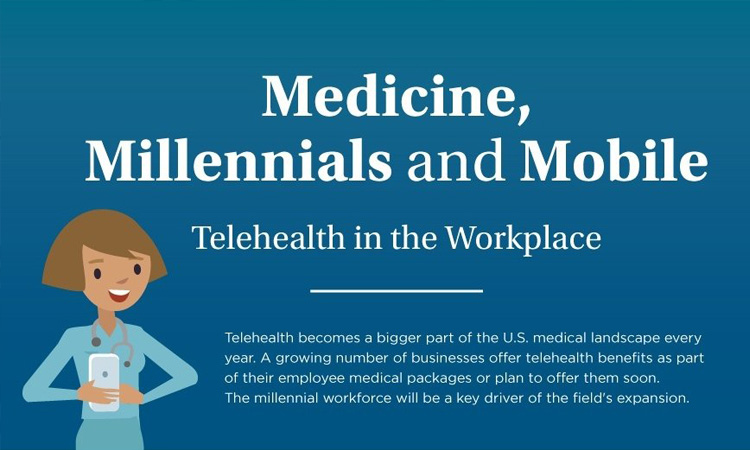Leaders who take care of their employees will find they'll take care of their companies; it's as simple as that.
A few years ago, mental health in the workplace was viewed as managing employee mental health issues directly impacting job performance and guarding against potential employer liability. Today, more employers realize that mental health, much like physical health is a constant human concern for every person every day. As a result, providing company-sponsored mental health support is quickly becoming the norm. Even...
|
Virtual primary care is a strategy to improve
employer-sponsored health plan members’ well-being and lower claims
costs. Aside from expanding access to care that is cost-efficient and
reliable, why should an employer offer virtual primary care to employees? Let’s
begin by analyzing employer and employee health challenges.
Drivers of Poor Employee Health and High Claims Costs
Poor employee health and high health plan costs are concentrated. 5% of health
plan members drive 50% of health plan costs. Additionally, 20%...
|
If you’re like one in three Americans, you've turned to Dr. Google to self-diagnose. What is that lingering pain in my leg? Should I see a doctor about this weird patch of dry skin? Dr. Google is always in. Always there to take in your symptoms and spit out a meaningful, medically-accurate diagnosis within seconds, right?
Wrong!
According to a study from Harvard Medical School, those free online medical symptom checkers:
- Are usually wrong. The correct diagnosis only came up first 34% of the time.
- Cause unnecessary doctor visits,...
|
As states reopen, many employees are returning to their physical workplace for the first time in months. The workplace can offer a welcome break from home distractions, but it comes with its dangers and stressors. Employers are heeding advice from the Centers for Disease Control and the White House, but what else can they do to support employees? Evolve their employee benefits. Here are four employee benefits that can support employees as they return to work in the wake of COVID-19.
Caretaker BenefitsMany parents, particularly...
|
From how we celebrate happy hours and weddings to how we learn and work, COVID-19 has pushed our lives into the digital space. How we interact with healthcare is no exception.
Doctors’ offices and hospital emergency rooms now pose a health risk, and more Americans than ever are looking to telemedicine (often called telehealth or virtual care) as a solution. Patients, doctors, regulators and employers recognize its potential to expand care for physical and mental health needs.
As a benefits professional, you need to know 10...
|
Corporate wellness
strategy design and implementation
We design,
communicate, and execute corporate wellness programs that align with your
company’s culture, budget, and health profile to maximize employee engagement
and sustained health improvements.
Health risk assessment
Data from our health
assessment gives employers insight into the collective health and risk
stratification of their employee population to help inform workplace wellness
program initiatives and introduce measures to help manage and reduce...
|
Nearly half of Americans say their mental health has been affected by the COVID-19 pandemic, according to the Kaiser Family Foundation.
It’s no wonder: Many Americans are out of work, isolated, stuck inside
and facing a global pandemic unlike anything we’ve seen in 100 years.
Mental Illness Was Already Common Before COVID-19
Many Americans faced mental illness before the pandemic, most
commonly anxiety, depression, post-traumatic stress disorder (PTSD) and
bipolar disorder. In fact, 1 in 5 Americans
experience...
|
I hope
everyone who made a resolution to be fit is starting to see a
difference. That said, if someone has been pretty sedentary, and he or
she jumps into a new fitness program too quickly, overuse injuries can
occur. Understanding how to pace yourself while getting fit is key.
Overuse injuries and common causes
Overuse injuries can be any type of muscle or joint injury like
bursitis, tendonitis, or stress fractures that are caused by repetitive
trauma. Overuse injuries are usually caused by:
- Biting off more than you...
|
Effective Diagnosis and Management of Infectious Diseases
Infectious diseases are widespread disorders and diseases caused by
organisms such as bacteria, viruses, fungi, or parasites. They cause
serious health problems worldwide. Common infectious diseases include influenza, methicillin-resistant Staphylococcus aureus (MRSA), Valley fever, urinary tract infections (UTIs), pneumonia, HIV and other sexually transmitted diseases (STDs), hepatitis C, and many other infectious diseases related
to travel. Signs and symptoms vary...
|
“Don’t stress it.”
This phrase has become common in our everyday language but do we take our own advice? Ah, if it were only that easy.
Stress is part of the human condition, it has been around since the beginning and isn’t leaving anytime soon. Instead of saber toothed tigers, rival cave clans or famine raising our blood pressure it’s our bank accounts, jobs and families that have us wound tight. So, can stress make us sick? In a word, yes. However, there are many factors to consider when looking at the impact of stress...
|
Over the years, TelaCare has begun to transform how (SMBs) small to midsize businesses provide healthcare benefits to their employees. This is a service that more employers are including to employees to attract and retain their workforce in a competitive job market. As you will learn you may want to include TelaCare in your companies benefits as well.
Providing outpatient medical care remotely
TelaCare utilizes modern communications technologies to provide patients with remote access to healthcare services. It’s primarily used for...
|
When focusing on the expenditures within an organization,
healthcare is one of the highest costs for employers. Cost-containment is a
term which employers frequently use, but what does it mean? Before we discuss
strategies, we'll first want to discuss what cost-containment is.
What is Cost-Containment?
Cost-containment refers to the practice’s companies utilize
to maintain the lowest expenditure levels possible for healthcare costs. A
primary focus is placed on - Thoughtfully
reducing unnecessary expenses
- Prevention
...
|
When illness strikes and your primary care isn’t available,
most people turn to an urgent care or emergency room. These settings offer more
hours and allow walk-in appointments, which works better than the traditional
physician office setting for busy patients. But these visits are costing you more than you think: in
both time and money. And most of
these cases can be diverted to telehealth visits for a fraction of the cost.
Here we break down how much these unnecessary visits really cost. Yes, you will spend a lot of...
|
TOLEDO, Ohio, Oct. 28, 2019 /PRNewswire/ -- Based on a
comprehensive analysis of U.S.-based private ventures, the Entrepreneur
Magazine's 360 list features organizations that demonstrate mastery of four
metrics: innovation, growth, leadership, and impact. TelaCare Health Solutions,
a national telemedicine software and service provider, was recognized for
leveraging its proprietary technology platform to meet a critical need in the
marketplace and become a leader in the telehealth industry while maintaining a
culture of...
|
Everyone knows that health care is
in trouble – skyrocketing costs, long wait times, and a physician shortage are
just a few of the problems – but rural communities are facing an even worse
situation. Since 2005, over 120 rural hospitals have
closed or gone out of business. And the trend is accelerating - approximately
two-thirds of those closures have been since 2010. This leaves many rural
communities and millions of Americans without access to needed care. Rural hospitals close for many
reasons, but it is not due to...
|
While telehealth has been slowly growing in popularity over the past
few years, it is officially time for brokers to start paying more
attention to this new model of care. Modern life is increasingly
happening online, and health care delivery is no exception. You may say that your clients already have telehealth – it’s embedded
in their health insurance plan. But here’s my question to you: how much is it being utilized?
If the answer is “not much” or “I don’t know”, that is a sign that
you have an...
|
Every year, millions of Americans suffer from a mental
illness. Anxiety, depression, obsessive compulsive disorder – they are much
more prevalent than you might think. And the rates of mental illness and
suicide are continuing to rise. Unfortunately, more than half of adults with a mental
illness do not...
|
Nearly 85 percent of people with employer-provided health
insurance in the United States have access to some level of
telemedicine. But hardly any of them use it. Why is that? Many of the problems in this industry stem from a “check the box”
mentality. Currently, most health insurers, employee benefits brokers,
and employers have the mentality that being able to say that
telemedicine is provided is sufficient. They are not closely evaluating
the solutions and competitors. Unfortunately, this mindset has led to...
|
Is it possible to lower costs while
maintaining a competitive benefits package? With healthcare and benefits costs
skyrocketing, this is the challenge facing companies today. New wellness
benefits bring promise, but how can companies be sure that they’ll deliver? Employers can’t afford to waste
money. HR teams need to scrutinize every dollar spent on employee benefits,
including new wellness programs. A wellness benefit that no one is using is
just money down the drain. That’s why utilization is a top
priority at...
|
Regarding Telemedicine and its benefits, phrases like “it’s included”, “no additional cost” or “free” may seem harmless, but should actually be major warning signs when coming from insurance carriers. These “free” benefits can end up costing your clients and their employees far more in the grand scheme of things - roughly $500,000 yearly for a 2,000-employee company. Let’s look at what your clients are getting from “free” benefits and the four reasons to avoid Telemedicine included in major medical...
|
Stress is costing US companies $300 billion every year due
to increased healthcare costs and missed work days, according to Business Insider. Not to mention the impact of lower
productivity, retention rates, and company morale. The costs of workplace
stress has placed stress reduction as a top HR concern at many companies. In
fact, 75% of US employers identified stress as their number one health and
productivity concern according to a 2016 survey by Willis Towers Watson. Working parents are especially
susceptible to high...
|
As health care costs for employers and employees have continued to grow, HR has struggled to find effective cost-containment solutions. While many employers have simply tried to shift costs and responsibility to employees, other employers have been looking for innovative solutions. In addition to telemedicine, one of the more popular ideas in recent years has been the implementation of on-site clinics. These clinics bring primary care to the workplace, making care more convenient and economical for employees. These clinics seem...
|
When it comes to a doctor’s visit, we all fool ourselves on the amount of time it takes. I’ll definitely be back for my 1 PM meeting or I can fit in an 8 AM appointment and not have to use any sick time. It almost never works that way. Traffic, waiting room lines, paperwork, and everything else all take time. You usually end up leaving hours later, wondering where the day went. So how long does getting medical care really take? Let’s take a look at how much time we spend at our current health care options for a common...
|
Are all telemedicine benefits the same? Why are some providers’ PEPM fees so much smaller? While it may seem like these companies are offering a comparable benefit at a much lower price, don’t be fooled by the tiny price tag. Unfortunately, these companies aren’t telling you the true value of their solution. To ensure you make the best decision for your company, you need to know what the telemedicine providers aren’t telling you in their sales pitch. Here are 4 things to watch out for when evaluating a low PEPM provider...
|
It's not rocket science that telemedicine can save your company money. But what would it look like if we took a deeper look at how those savings come together? We've created a simple info graphic to help you see how your telemedicine benefit lowers your bottom line. So even if you're new to the concept, you can see why so many are choosing to offer this service for their workforce's! Choosing to provide telemedicine for your employees is a no-brainer after you've seen the numbers. Reduce the number of ER, urgent care, and...
|
The priority of the majority of employers and their healthcare benefit
administrators is preventing rising costs in healthcare. While medical, dental,
and vision policies are included in benefits packages for every employee, the
escalating costs within the industry might sway you to check out alternative programs
and their quality benefits to offset a heavy financial hit.
One option is a health plan with a high deductible. Employers are more
commonly offering high-deductible health plans for their employees in an
attempt to...
|
Health care costs are rising, and it
seems like almost everyone is worried about it. It’s putting many employers in
a tough situation, where they need to balance their bottom line and their
employees’ well being. To attempt to control the rising
cost of care for employers, they often try to shift more cost and
responsibility to the employee. So how can companies continue to provide
meaningful benefits to their employees? As employers shift costs, employees
are struggling to pay for healthcare, and it could be...
|
TelaCare (www.TelaCare.com)
is among one of the fastest growing telemedicine companies in the nation.
Specializing in telephone and video medical consultations, providing access to
affordable, convenient care from board certified doctors and pediatricians
anywhere in the United States. TelaCare’s service allows members to quickly
receive non-emergency care without having to wait to see a primary physician,
urgent care clinic, or emergency room.
TelaCare is focusing on technology and user experience to fill the current
gap...
|
We’ve all been there: sitting in the waiting room at an urgent care
clinic, waiting and waiting for a doctor to prescribe you an antibiotic for
what you already know you (or your child) have. Now imagine if instead of taking off work or using PTO to sit in a
waiting room, you could simply call a doctor and have a prescription in hand in
less than fifteen minutes.
Urgent care centers are great facilities for many medical problems.
Fractures, concussions, and the need for stitches are all examples of issues
best handled at an...
|
Remember what employee benefits meant 10 years ago? Most likely a healthcare
program, a sweet 401k, and a parking spot - maybe a name plate if you were
really lucky - and that was pretty much it. Then millennials entered the job
market and everything shifted. Now, in 2016, the way businesses treat their employees has drastically
changed. Google pays 20% time for work on outside projects, Evernote offers its
staff house cleaning twice a month, and LinkedIn even has a stage for aspiring
musicians.
Sure, it would be nice to...
|
Every year during annual enrollment, you eat, drink, and breathe health care
benefits. Then once annual enrollment is done, you probably stop thinking
entirely about benefit implementations. But this would be a mistake. Sometimes ancillary benefits actually can and should be implemented
off-cycle. Telemedicine is a great example. It’s an easy, money-saving program
that can actually be beneficial to implement outside of the regular plan
renewal period. Here are three reasons you should consider implementing...
|
Open enrollment is a stressful time of year for HR professionals. Rising
healthcare costs, changing regulations, and uncertainty around the future of
the ACA all make benefits increasingly complex. HR teams are tasked with
simultaneously trying to cut costs and providing valuable benefits for
employees. This is an almost impossible challenge. While the list of benefits
concerns is long, cost containment, engagement, and specialty pharmacy are
three of the top issues that HR professionals are stressing over this year.
Cost...
|
From passing stomach bugs to letting their little noses run wild, kids might
as well be walking, talking germ bombs, racking up those school sick days like
they're collecting Pokémon. Even worse, some 39% of mothers end up also taking
sick days in order to care for their wee ones. If you feel like you're taking
your kid to the doctor's office as much as you are soccer games or gymnastics
practice, perhaps it's time to focus on fighting the illnesses that can keep
our children from sitting at their desks and learning. And...
|
How did your last telemedicine implementation go? What kind of results did
or are you getting? Do you even really know what results you are getting? With most providers, you were probably given access to an online repository
of fliers and brochures to use. All the human resources department had to do
was pick something, download it, and send it to employees. Seems easy, right?
But when you got the reports back on usage, you may have noticed the results
weren’t great.
A Few Canned Emails Isn’t Enough
For many employees,...
|
TelaCare has the leading utilization rate in the telemedicine industry. How
do we do it? By creating and implementing a highly effective, customized
engagement program for you and your employees to increase awareness and
engagement. That means our clients save more, with less work for their human
resources departments. In fact, we’re so certain of our solution and
implementation that we even offer a savings guarantee. For our self-funded
clients, we guarantee that the money saved from diverted health care visits
will be...
|
As you sort through various vendors in of search of employee benefits, it's
important to be aware of their sales pitch. For you, asking detailed questions,
double-checking on references, and evaluating the numbers should all be a part
of the process. Since many vendors offer similar benefits to one another, their
biggest competition factor relies on the price. So, how can you tell if that
one company offering a surprisingly low price is really too good to be true?
This is exactly what telemedicine companies offering low PEPMs...
|
You wouldn't buy electronics from the dollar store, right? Of course not, because you know the old saying is always true - you get what you pay for. Not only does cheaper often translate to poorer quality, but it only ends up costing you more money in the long run from having to replace that terrible product that doesn't last as long or as well as the more expensive alternative. The same logic applies to telemedicine. What's often said by employers to their consultants is that there are benefits included in major medical plans at...
|
FISHERS, Ind., Dec. 1, 2017 /PRNewswire/ -- StickyJ Medical ID (affectionately known by many as StickyJ) was founded in 2000 by Lori Torman
with the goal of selling personalized photo pins that could hold a
sticky-back photo. StickyJ mixes fashion and style with function and
purpose as one of the foremost e-retailers of contemporary medical
emergency bracelets, awareness jewelry and licensed designs for men,
women, boys and girls. StickJ is committed to helping people protect
themselves without feeling branded by their...
|
It’s probably not news to you that telemedicine
is starting to revolutionize healthcare. Many of your clients may have
implemented plans, and you’ve likely seen the presentations by big medical
insurers. But you may have also seen that many of these plans aren’t delivering
on their promises.
But telemedicine is still changing.
Face-to-face interactions have decreased in almost all industries, and medicine
is certainly next. Better cellular networks and wifi hotspots and the increase
in smartphones and tablets makes...
|
It's that time of year every employer dreads - flu season! It's an
inevitable fact that folks around the office will get sick and have to take
time off of work, losing valuable productivity time for the company. But just
how big of an issue are employee sick days and what is the overall impact it
can have on an employer?
THE NUMBERS
In 2015, workers in the United States took off an average of 4.9 sick days.
That doesn't seem like too big of a problem until you consider that number
applied to, say, a company of 1,000 employees....
|
FISHERS, Ind., Oct. 31, 2017 /PRNewswire/ -- TelaCare,
a national telemedicine technology and services company, announced
today that it has added a life-saving medical ID system in addition to
its telehealth and counseling services on TelaCare, one of the fastest growing telemedicine companies. TelaCare's new ViewMyID medical ID system is
the easiest way to access, store, and manage patient's health
information for easy access in an emergency. Patients profiles can be
accessed anytime, anywhere via TelaCare's products...
|
Making healthcare affordable and convenient is a priority for many
employers. And when looking for new and different offerings, onsite clinics and
telemedicine programs may be top of mind. While both programs have their
benefits, employers should consider their goals, priorities, and limitations
before choosing one of these solutions over another.
Ease and Availability
Onsite clinics: Onsite clinics allow employees to
easily and quickly visit a physician during the workday, with minimal time away
from work. If appointments...
|
FISHERS, Ind., Sept. 15, 2017 /PRNewswire/ -- TelaCare, one of the fastest growing telemedicine companies, announced today that it has added unlimited access to board certified Pharmacists, Dentists, Optometrists, Dietitians, Sports Medicine and Alternative Medicine professionals. These specialties will provide unlimited no additional cost consultations in addition to its telehealth services on TelaCare, one of the fastest growing telemedicine companies. Patients can now easily get their medical
questions answered in an array of...
|
2016 is almost officially upon us, and a new year means a fresh start. For
most people, it's all about setting resolutions and goals to kick-start some
positive changes. Meanwhile, many folks were overcome with a different emotion
once the clock struck midnight - one of worry.
Just as sure as New Years is welcomed with the festive sounds of cheers and
Auld Lang Syne, health plan deductibles also reset. For all of your
employees who elected HDHP’s late last year, now is the time for them to open
up those wallets if...
|
FISHERS, Ind., Aug. 24, 2017 /PRNewswire/ -- TelaCare,
a national telehealth technology and services company, announced today
that it has added behavioral health services in addition to its
telehealth services on TelaCare, one of the fastest growing telemedicine companies according to Telemedicine Magazine. Patients can now speak to U.S. board-certified
counselors on the TelaCare app via scheduled appointments. They're
finding doctors who can treat them at any time and any place, in the
comfort of their own homes –...
|
Benefit renewal time is extremely busy - just talk to any overworked HR
employee or benefits consultant! With contract renewals, benefits planning, and
open enrollments, telemedicine can sometimes get ignored or forgotten. While it
may not seem as important as the other pieces of a medical plan, an effective telemedicine
program is a low-cost, high-ROI benefit that is truly appreciated by employees.
Luckily, telemedicine can actually be implemented year-round. So even if you
missed it during this year's enrollment cycle, you...
|
Is telemedicine just a box that you check as you go over your client’s
medical plans? Do you even know the benefit your clients’ telemedicine plan is
providing, and, more importantly, do your clients know it’s value? Measuring the benefit of telemedicine can seem difficult, but it really all
comes down to one number: the utilization rate.
Utilization rate is an indicator of dollars saved and employee
satisfaction. It’s an easy to understand, easy to communicate, easy to remember
number. In short, it’s the magic...
|
Seeing a doctor when you are sick can be a hassle. First, you have to figure
out where to go. Then you have to get there, register, wait, pay, hopefully see
a doctor in under an hour or two, and then finally get home via the pharmacy,
which hopefully has a drive-thru option. Now imagine a world where you don’t have to leave your house to access a
doctor, you don’t have to wait and you don’t even have to pay a co-pay.
Believe it or not, this world actually exists in the U.S. today. TelaCare allows patients to
access a...
|
Companies have lots of choices
these days when it comes to reducing healthcare costs. Onsite clinics,
and onsite kiosks, offer on-demand and immediate care to employees at
work. Several large employers, including the Palm Beach County School
District, Jet Blue Airways and the municipality of Kansas City, Mo.,
have installed telemedicine kiosks at their work sites to spare
employees a trip to the doctor’s office--saving themselves--and their
employers, money in the process.
While telemedicine kiosks may seem like a...
|
Telemedicine benefits aren’t just a passing employee benefits
trend. More than 80% of large employers surveyed by Towers Watson say
they will offer a telemedicine benefit by 2018. As a result, carriers are offering telemedicine in their major medical plans. Your clients might have the opportunity to choose their carrier’s telemedicine benefit–but before you promote this option for its convenience, it’s
essential to remember that carrier-provided telemedicine and
employer-provided options are much, much...
|
I sit here and I wonder why more are not using telemedicine? There is
nothing on the market like it! Wellness programs, onsite clinics, whatever else
on top of a health plan you have is fine but they typically do not provide
24/7/365 access to a national network of U.S. board-certified doctors.
Telemedicine is a simple tool, very little paperwork, next to no admin
work, and it lowers the number of claims, it is a non-insurance product
and I hope it stays that way. So if there is a product that can lower claims,
lower cost,...
|
Years of data have demonstrated the
benefits of telemedicine. It reduces costs, improves access to services, and
eliminates the lost productivity that results from traveling to and from health
care appointments. The data has swayed corporations, insurance companies, and
even government agencies to contract with telemedicine services. Recently,
thanks to insight on the part of government health payers and insurance
companies, it has become possible for telemedicine companies to offer mental
health services, making it easier...
|
If you you've been laboring under the impression that telemedicine is
something that primarily applies to radiologists and a few surgeons who operate
robots, then you probably haven't talked to Micheal Sharp, the communications
director at TelaCare. If you do, he'll tell you all about the telemedicine
kiosks that TelaCare manufactures. From wall-mounted stations in private rooms
to soundproof structures with enough medical equipment inside to make a doctor
on the Starship Enterprise jealous, kiosks are being installed in...
|
Companies are selling telemedicine to businesses as a commodity. It’s all about
who can sell it to you at the lowest price. Has anyone ever thought about how
many employees actually setup their account or even use it? I wonder if the
$2-$3 price point is a good deal? Companies are finding that it is NOT
the great deal they once thought it was. If you look at the ROI you will find
that most of the employees never setup the account and even fewer use it…why?
The answer is... you bought into a product/service for a great...
|
Savvy, successful telemedicine programs are always marketing from selling the proven benefits of telemedicine to gain initial support, to later touting the experienced, measurable impact of telemedicine to drive continued usage and expansion. Before a telemedicine program gets started, understand the concerns of the parties whose support is ultimately needed for the program to fly. Understand their concerns and objectives and deliver a message and solution that incents them to support telemedicine in their company. After the...
|
Industry experts estimate that by
2018, 80 percent of employers will be offering a telemedicine benefit to their
employees. To uncover what’s behind this
growth, and to gain an understanding of employer involvement with and
perceptions of telemedicine, American Well, creator of the Amwell telemedicine
app, conducted a broad survey. They invited companies of all sizes,
from small organizations with fewer than 1,000 employees to large companies
with over 20,000 employees. They heard from companies across a variety...
|
You worked hard with your clients to develop strategic benefits plans that
took into consideration both their needs and their company culture. This
wasn’t a simple process with the current state of healthcare and its rising
costs. Insurance costs are up nearly 70% in the last 10 years, and
it’s no easy task to be a broker these days. You want to see the fruits of your labor by seeing the employees use
the benefits to not only make their lives better, but drive savings for your clients.
Without high utilization, your...
|
One of the biggest changes consumers will deal with in the future are those brought about by the Affordable Care Act. With its enactment, as many as 30 million people will become eligible for health insurance. As a result, wait times to see a doctor will grow along with the higher patient volume. This works in favor of practicing physicians but sets up a barrier to health care for employees that need it.
The type of health care plans employers is choosing for employees is also changing. More employers are opting for plans with...
|
For better or worse, social media is
a major channel through which clients and potential clients learn about a
company. In telemedicine, it is tempting to think that customers and
prospective clients don't want to connect on social media, the reality is that
many do. Ignoring social media simply is not an option for any business. Smart
use of social media, however, can produce new client connections, strengthen
existing relationships, and improve utilization rates. All of that translates
into increased revenue and happier...
|
Telemedicine is a great way to save
money and provide employees with a convenient way to manage their health. It is
also a term that strikes fear into the hearts of human resources directors.
Like any benefit, telemedicine only saves employers money if employees utilize
it. Believe it or not, the industry-wide
average utilization rate is just under 5% and there are some companies with
utilization rates as low as 1%. This fact terrifies finance executives, who
know that a low utilization rates means that telemedicine...
|
Marketing follows the same rules
regardless of the industry. Whether a company is selling widgets at rock-bottom
prices or offering a unique service like telemedicine companies do, the rules
are always the same. Unfortunately, a quick walk through any conference, like the
Healthcare Information and Management Systems Society (HIMSS) conference,
reveals a problem in the telemedicine industry - a glut of "me-too"
marketing.
Sure, the technology on display is amazing and some of the products will be top
of mind, but will people...
|
Telemedicine services are designed
to reduce medical costs, but some employers don't see the benefit because they
are paying more than $500 for every employee visit. That price is well above
what even traditional medical care costs. Why does this happen? More
importantly, how does it impact a company's bottom line and how can we change
it?
If employees aren't utilizing the service, it will simply be overhead with no
return. Surprisingly, not all telemedicine services have low utilization rates.
In fact, some have rates as...
|
There has been much written lately
about telemedicine, and thanks to the efficient and progressive nature of the
technology, the majority of that literature has been positive. However, many
still wonder what it all means. Yes, telemedicine can improve inefficiencies, reduce
re-hospitalizations, and save money for the healthcare system, but is it
actually helping patients? The short answer is yes, especially those patients
with chronic conditions who require regular monitoring, consultation and
education. When I was a kid, we...
|
Companies are selling telemedicine
to businesses as a commodity. It’s all about who can sell it to you at the
lowest price. Has anyone ever thought about how many employees actually setup
their account or even use it? I wonder if the $3 price point is a good deal?
Companies are finding that it is NOT the great deal they once thought it
was. If you look at the ROI you will find that most of the employees never
setup the account and even fewer use it…why? The answer is... you bought into a
product/service for a great...
|
The family care/urgent care industry
is a diverse playing field where innovative leaders have built successful
models to address the demand for convenient, cost-effective and patient care. This overview focuses on the
telemedicine industry—a service model gaining great interest in this time of
change and innovation.
What is telemedicine?
Telemedicine, which uses technology
and mobile devices to connect patients for real time consultations, is adding a
new dimension to healthcare. It offers an alternative, affordable and...
|
We are seeing more employers turning to
telemedicine than ever before. There are many reasons.
- There is a national shortage of physicians
- There are more people getting insured, exacerbating the
shortage even more
- Employers are shifting more cost to their employees
through HDHP plans. Telemedicine provides a lower cost alternative for
common primary care services.
- Companies are focused on "managing risk" and
using telemedicine as a great alternative to expensive urgent care and
ERs.
Read More
|
We tend to take the Internet for
granted. The changes that it has brought about in society have made us all
wonder how we ever lived without the constant connection, access to
information, and speed of service that the Internet provides. Thanks to the
Internet, our lives are more convenient and richer than ever. Telemedicine
services are now bringing the convenience (and cost savings) of the Internet to
the health care industry.
Interacting with the medical
establishment takes both time and money, two major problems that...
|
Companies are selling Telemedicine
to businesses as a commodity. It’s all about who can sell it to you at the
lowest price. Has anyone ever thought about how many employees actually setup
their account or even use it? I wonder if the $3 price point is a good deal?
Companies are finding that it is NOT the great deal they once thought it
was. If you look at the ROI you will find that most of the employees never
setup the account and even fewer use it…why? The answer is... you bought into a
product/service for a great...
|
In America, efforts to maintain a healthy society are being challenged by population growth, rising healthcare costs, a lack of access to medical facilities and a serious shortage of physicians that is expected to exceed 100,000 in the coming years. TelaCare is tackling these daunting problems by providing a breakthrough solution that unites healthcare providers and patients in a remarkable new way. With help from INTERSTAR Media, LLC and Vidyo, we've created a new turnkey Telemedicine system that provides a complete practice...
|
Telemedicine is a growing force in the health
care industry, driven by consumer demand for fast and affordable health care.
Consumers and employers alike are searching for cost-effective health care
solutions that are easy to access. Telemedicine fills this void in the
health care marketplace. Telemedicine technology is nothing new. It’s
been around for over forty years. Hospitals and home health care services were
among the first to adopt it. Telemedicine makes it possible to connect health
care providers with patients...
|
Love them or hate them, Millennials are about to be the
biggest living adult generation in the United States. And they have a
completely different view of healthcare than generations before. I’m personally part of Generation X – a generation that
firmly believes in annual physical check up with a primary care physician that
we’ve likely seen for years. We don’t question our doctors or challenge their
recommendations. We have a list of specialists and maybe even a mental health
professional. Then there are the...
|







































































